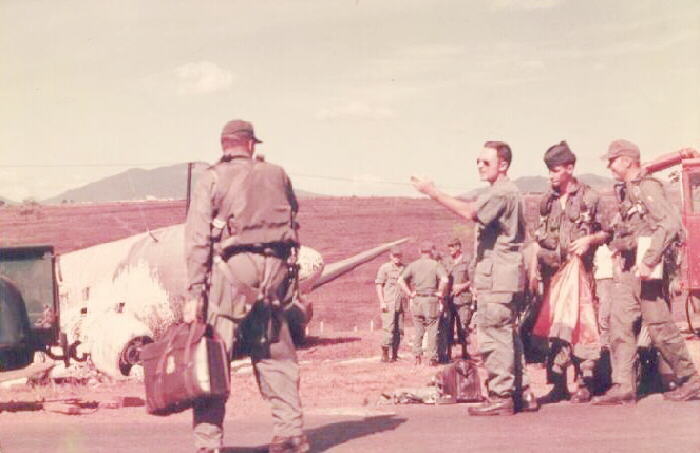EC-47 43-48702 Crashes December 31, 1968
The following based on USAF Accident/Incident Report dated December 31, 1968.
Aircraft Crewmembers
Capt. John A. Bator - Pilot
1st Lt. James B. Dobbs - Co-Pilot
Major Walter J. Brooks - Navigator
TSgt Gerhard R. Frenton - Flight Mechanic
SSgt Robert N. Hudak - Radio Operator
SSgt Randall R. Williams - Radio Operator
History of Flight
On 31 December 1968, at 1435 hours, EC-47P, aircraft SN 43-48702, call sign
Cap 19, started takoff roll on runway 09 at Pleiku Air Base, Republic of
Vietnam. The flight was approved by 460th Tactical Reconnaissance Wing as
mission number 2770. Programmed enroute time was to be 7+00 hours with recovery
at Pleiku AB.
The maintenance preflight inspection of the aircraft was accomplished by the
ground crew at approximately 0030 hours. The Pilot and crew reported to the
squadron at 1325, briefings were conducted, clearances signed, and they arrived
at the aircraft at approximately 1345 hours. The required preflight inspections
were completed by the individual crew members and no discrepancies were noted.
Everything continued normal until completion of the "Before Takeoff Check" as
the aircraft was holding number one for takeoff short of the runway.
At about this time, fumes that smelled like alcohol were noticed by the pilot,
co-pilot and flight engineer. A check of the cockpit area was made. The
hydraulic compartment, isopropyl alcohol tanks lines, switches and controls
were found to be normal. The pilot detected a damp area on the bulkhead padding
behind, above, and to the left of his head. The flight engineer checked this
area nad the area on the opposite side of the bulkhead which he also fould damp.
The pilot and engineer suspected that this dampness came from an alcohol vent
line that ran through the area. The co-pilot thought the fumes could have come
from other aircraft that were running up in the area or from a C-123 that had
just landed.
The fumes finally dissipated and the pilot believed that a safe mission could
be flown as fumes were no longer persent. He was also approaching his scheduled
takeoff time and three aircraft were waiting behind him.
The aircraft was cleared into position to hold after a landing aircraft. Two
light aircraft were cleared to takeoff at midfield ahead of him. After the
second one started to roll, the pilot advanced his power to 30 inches manifold
prssure and obtained satisfactory power and systems sheck. When cleared for
takeoff, he released his brakes and advanced the throttles to approximately
40 inches. As briefed, the co-pilot continued the throttles to maximum takeoff
power.
Shortly thereafter, during the takeoff roll there was a return of very strong
fumes, which immediately brought tears to the eyes of the crew members in the
cockpit. The co-pilot quickly opened his side window. The pilot reached for
his side window with his right hand. The aircraft started to slowly veer to
the right. As the aircraft approached the right side of the runway, the pilot
corrected with hard left rudder. The aircraft swerved to the left and departed
the runway about 1300 feet from the takeoff end at an approximate 45 degree
angle.
At approximately this point the throttles were retarded. The aircraft continued
across a depressed median, up and over a taxiway, through a perimeter fence,
crossed a road, striking a wrecker and a jeep, coming to a stop astride a
culvert.
The driver of the jeep suffered a minor laceration of the head. The aircraft
came to rest at a position approximately 1700 feet down the runway and 400
feet off to the left side. The Pilot turned on the alarm bell, turned off the
individual ignition switches and the battery switch. The crew evacuated the
aircraft without difficulty. One crew member receiving a minor injury ( The
Navigator sprained his right thumb ).
The crash equipment was at the accident scene almost immediately. The flight
line fire truck responded even before the aircraft crossed the median. The
tower sounded the crash alarm as the aircraft left the runway. The fire
department put out a small fire in the right engine and EOD removed all
explosives (Flares, guns, etc.) from the aircraft.
These photos also shown in 'The EC-47 Wreckage Photo Album',
On This Site.
This Photo came with a pack from History files of the 360th
at Tan Son Nhut, but matches the accident/incident at Pleiku with
aircraft 702.
The three (3) Photos below, all of the same aircraft incident
involving aircraft 702. were provided by Joe Martin, who got
them on a recent visit to the History Archives located in
College Park, Maryland. Thanks, Joe
The three (3) Photos below, all of the same aircraft incident
involving aircraft 702 were provided by Danial R. 'Danny' Howser.
They include in order, another view of the wreck, the Jeep the
aircraft hit, and the wrecker the aircraft hit. Thanks, Danny
 |
| This Photo was provided by Robert W. Hudak. Robert was a Radio
Operator on this Mission, aircraft 43-48702 on December 31st 1968.
Personell, left to right. - Captain John A. Bater, Pilot holding
the mission bag. - Group of people in the background are responding
base personell. - Man with his arm raised and wearing sun glasses
is the responding Flight Surgeon, (probably arrived with crash crew.)
SSgt Robert N. Hudak, Det. 2 6994th wearing the orange jacket and
carrying the mission bag, was seated at the 'Y' position on takeoff.
SSgt Randall R. Williams, Det. 2 6994th in the fatigue hat, was seated
at the 'X' position on takeoff. |

|